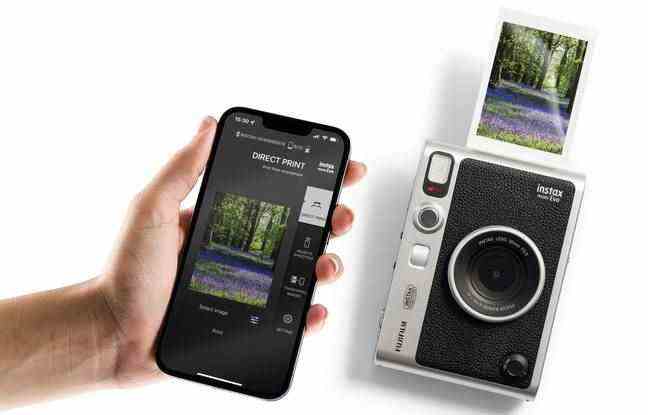After its imposing Instax mini 40, Fujifilm is launching its
Instax mini EVO. Another instant camera? Yes, but perhaps more desirable than some of those predecessors. Cultivating more than ever a looks vintage, the little new one which is sold for 199 euros doubles as a photo printer for smartphones. It also allows you to check the quality of your shot on your screen before printing it. A good point in a universe where some may be reluctant to afford an instant camera because of the price of consumables and the fear of failed prints. “20 Minutes” checked if you could flash on the Instax mini EVO.
Large screen for aiming
With its design seventies claimed, the Instax mini EVO looks great. Although of a very plastic construction, this instant camera (122.9 x 87 x 36 mm for 285 grams) has a real sympathy capital, far from certain massive Instax looking like children’s toys. Much more adult in its design, the mini EVO is also in its approach.
At the rear, the device has a 3-inch (7.62 cm) viewfinder, but it is non-touchscreen. If this replaces the classic gun-type viewfinder found on the Instax, it offers much greater comfort. From then on, you can play with the lens ring and choose from ten optical effects on offer (vignette, blur, blur, fisheye, color leak, mirror, double exposure, mirror, etc.). At the same time, you can opt for one of the ten types of films offered by turning the ring on the top of the device (bright, pale, monochrome, sepia, yellow, red, blue, retro, etc.). That’s a hundred possibilities in total.
Among these creative formulas, we particularly appreciated the mirror effect coupled with monochrome, which helps to achieve great images. Above all, the screen of the mini EVO allows you to check that you are not going to print a failed photo… and lose almost a euro.
Funny, to start printing, it is necessary to activate the cocking lever located on the left of the case, as was done in the past with a film camera in order to scroll the film inside the case after a take of views. Nice wink!
Note that the camera’s flash can be deactivated, which has not always been the case with the Instax. Finally, be careful: apart from cropping, it is impossible to apply effects afterwards to a photo taken with the mini EVO. This operation must be carried out at the time of shooting.
The camera’s CMOS sensor is only 4.9 million pixels. The lens, a 28 mm (f/2.0) is fairly versatile, but allows views from 10 cm to infinity. The photos taken are revealed in about 4 minutes. They remain of honorable invoice, but lack details, as usual with Instax. However, this is not the case for photos printed from a smartphone.
An excellent smartphone printer
Thus, the Instax mini EVO can turn into a Bluetooth printer. A mission which he performs brilliantly through an application. But in a limited way. Because here, it is impossible to play with the 100 creative possibilities offered when shooting directly from the instant camera.
For an image from the library of your smartphone, it is nevertheless possible to carry out via the application cropping, rotation, to apply three filters (monochrome, sepia, automatic) and to adjust the brightness, the contrast and saturation. No more. But it’s already not bad. And enough to see that the mini EVO prints beautifully.

There are two reasons for this: photos taken with a smartphone are natively of better quality. And the mini EVO prints in 600 dpi (dots per inch), or with a level of finesse never before achieved on an Instax device. We are much more seduced here than by the perfectible quality of the photos printed by the Canon Zoemini S2, for example. This instant camera/printer certainly cheaper (129 euros), uses the Zink printing process, which produces images with strong red dominance.
On arrival, Fujifilm signs a hybrid and attractive instant camera with which the creative possibilities are numerous. We feel much freer than with the Polaroid Now + (149 euros) which, if it can connect to an application to add effects to its photos, does not have a viewfinder.
We regret that there is no similarity of filters and retouching for the images that can be customized when shooting and those for printing from a smartphone. The cost of a print in the 6.2 x 4.6 cm format is 0.89 euro. Named Stone Gray, a new film with metallic gray borders is appearing. If it raises the bill to 0.99 euros per view, it is ideal for showcasing its black and white shots.

